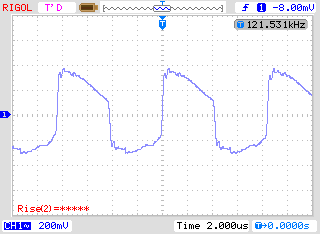February 15, 2011
5 min. read
When the Palm Pre was released, Palm also sold a unique inductive charger called the Touchstone. Inductive charging isn’t new, by any means. Electric toothbrushes and many other devices have used them in the past. This was a first for cell phones, I believe.
When I purchased my Pre and eventually many Touchstones, I didn’t have a good oscilloscope to play around with the signals. Now I do. With the announcement of HP’s new phones and an expansion of the TouchStone coil functionality in the phone, I thought I would take a look.
I guess I should start will a little explanation of Touchstone charging. The charger is a base with a coil embedded in it. The phone also has a coil embedded into the back. In addition, both have magnets to align the phone and base coils together. You slide the phone onto the Touchstone and the magnets pull it to the correct spot for alignment.
A transformer is a set of two coils, used to transfer AC signals from one side to the other. They are most commonly used to reduce household voltages for use by devices (after rectification of the AC signal into DC). The transformer is the largest component in the big “wall wart plug” power supplies, supplied with so many electronic devices.
Transformers are also used for isolation. Since only a changing magnetic field can induce a current in a wire, DC cannot be passed through a transformer. This is useful when a circuit had a DC bias, along with an AC signal, and you only want the AC signal. On a computer modem, you usually see a transformer used to interface with the phone line and isolate the delicate circuitry from a line that can have fairly high voltage on it. So they can be used for signals, not just power.
The side of the transformer that provides the power is called the primary, the coil in the Touchstone in this case. The receiving coil of the transformer is the secondary, the WebOS phone’s back. Since the Touchstone is powered by 5V 1A USB plug, it has its own oscillator to make a varying signal to drive the coil. But what does this signal look like?
I used a simple two coil wire antenna around the base of my Touchstone, where it meets the Pre. This is acting as another secondary for the transformer. The voltage induced into the coil is proportional to the number of turns, so my coil has a very low voltage. However, the scope has enough sensitivity to sample the frequency and waveform characteristics of this small signal.
Displayed on the upper right is the waveform frequency, which varied between 121-123 KHz. This is a higher frequency than I expected, as I remember that losses go up in transformers with frequency. I am not a radio frequency engineer, so I am sure they figured out that this frequency is best (and/or was a location on the RF band for which they could get permission from the FCC to operate.) Without having iron cores of typical power transformers, it must be more efficient to transfer power at these higher frequencies.
The reason I started looking at this were the frequencies from the FCC report, tweeted about by @WebOSInternals. The HP Veer’s Touchstone back has a receive frequency of 118.5 KHz and a transmit frequency of 3.1 MHz.
I thought neither of these would be charging frequencies, as they both seem fairly high. I was wrong. With the analysis of the original Touchstone, it is obvious that the 118.5 KHz is the charging frequency of the new Touchstones. This is close enough in frequency that old WebOS phones will charge on new Touchstones and new WebOS phones will charge on old Touchstones. (HP’s presentation on the 9th actually showed a new device on an old Palm branded Touchstone.)
In radio antennas, there is a property call resonance. This is where the antenna is tuned such that the maximum amount of power is transferred to the antenna. Otherwise, energy is just lost in the circuitry before the antenna and the transmission power is lower than it could have been. Antennas resonate at multiples of a given frequency. So a coil antenna that is tuned to resonate at 118.5 KHz would also resonate at 26 times that frequency or 3.08 MHz. Now we know why these specific two frequencies were selected and why the Touchstone charging frequency has changed slightly.
What is unknown is if new Touchstones will use the 3.1 MHz to communicate with the new devices. It would be a method of identifying exactly which Touchstone you are on if they told the phone a unique ID. This would be a great way for the phone to have different functionality at different locations, in the new exhibition mode. What is known is that new devices communicate with each other via the 3.1 MHz frequency over each device’s Touchstone charging coil.
I can’t wait to put a new device and Touchstone on the scope and see what the data looks like.


